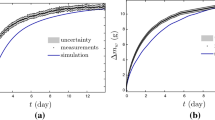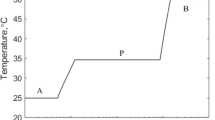Abstract
Phase change phenomena in moist porous media with low liquid content, the typical condition of a porous body at ambient conditions and far from the contact of liquid water, are controlled by the shape of the adsorption isotherms and by the effective liquid-vapor thermodynamic condition within the pores. Usually, heat and mass transfer models are developed under the assumption of thermal and hygrometric equilibrium. This gives rise to an expression of the evaporation source that is too complex in view of the dynamic identification of thermophysical and transport properties of a porous material. In this study, the hypothesis of hygrometric equilibrium is dropped. The phase change rate is considered proportional to the amount of local nonequilibrium through an appropriate delay coefficient. This approach leads to a simple representation of the process and makes manageable the formulation of a coupled heat and mass transfer inverse problem. A comparison with a first group of experiments performed with an open-pore light insulating material (expanded perlite board) confirms the suitability of the proposed approach. However, the analysis shows that, for this material, phase change occurs not far from the hygrometric equilibrium.
Similar content being viewed by others
REFERENCES
A. V. Luikov, Heat and Mass Tranfer inCapillary Porous Body (Pergamon Press, Oxford, 1966).
S. Whitaker, Advances in Heat Transfer 13:109(1977).
D. De Vries, Int. J. Heat Mass Transfer 30:1343 (1986).
P. Crausse, G. Bacon, and S. Bories, Int. J. Heat Mass Transfer 24:991 (1980).
K. Vafai and Sarkar S.,J. Heat Transfer-Trans. ASME 108: 667 (1986).
S. Hokoi and M. K. Kumaran, J.Thermal Insul. and Bldg. Envs. 16:263 (1993).
C. V. Le, N. G. Ly, and R. Postle, Int. J. Heat Mass Transfer 38:81 (1995).
N. E. Wijeysundera, J. ThermalInsul. and Bldg. Envs. 19:348 (1996).
G. Milano, F. Scarpa, and G. Timmermans, in Thermal Conductivity, Vol. 22, T. W. Tong, ed. (Technomic Publishing Co., Lancaster, Pennsylvania, 1994), pp. 263–274.
F. Scarpa, R. Bartolini, and G. Milano, High Temp.-High Press. 23:633 (1991).
G. Milano, R. Bartolini, and F. Scarpa, HighTemp.-High Press. 26:177 (1994).
F. A. L. Dullien,in Porous Media, Fluid Transport and Pore Structure (Academic Press, New York, 1979), p. 225.
Author information
Authors and Affiliations
Rights and permissions
About this article
Cite this article
Scarpa, F., Milano, G. The Role of Adsorption and Phase Change Phenomena in the Thermophysical Characterization of Moist Porous Materials. International Journal of Thermophysics 23, 1033–1046 (2002). https://doi.org/10.1023/A:1016338019265
Issue Date:
DOI: https://doi.org/10.1023/A:1016338019265




